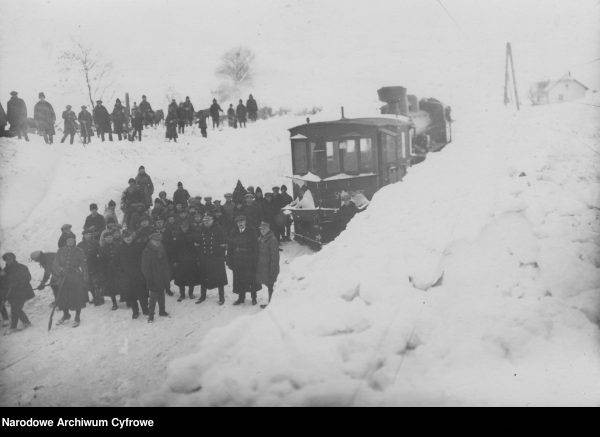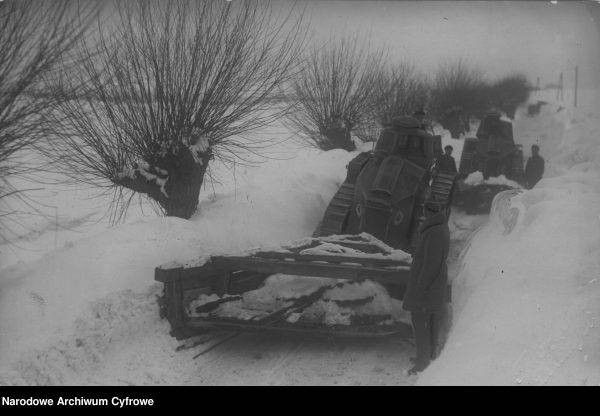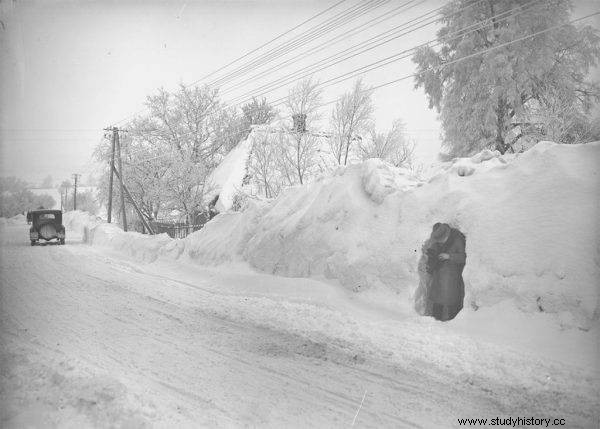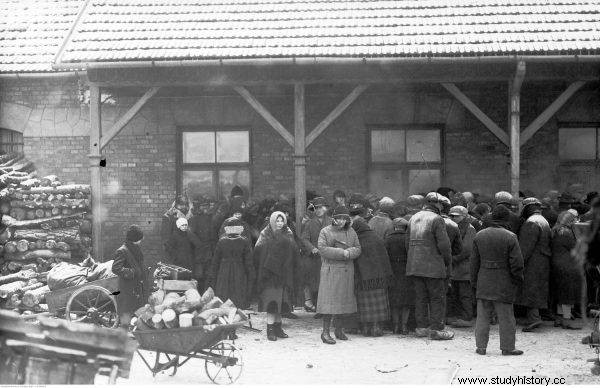In the first weeks of February 1929, the Siberian Highway moved extremely far to the west, and covered all of northern and central Europe, up to the Alps. Together with him, among others winter has come to Poland, which has not been seen for years. It is no coincidence that it was called the winter of the century.
Snow Mountains
In the first half of October 1928, snow fell in the mountains. And while the situation was not a surprise for the highlanders, the shepherds told their grandchildren about what started a few weeks later. Besides, not only them. In the first days of December, white powder covered Polish streets, fields and forests. The snow cover was steadily increasing, and the subsequent negative temperatures meant that it remained in almost all localities until April 1929. In the capital city, at its peak, it was 74 cm thick. However, this value is poor when it is compared with the measures taken in the vicinity of Morskie Oko, where on April 9, 1929 as much as 267 cm was recorded. .

Snow removal from tracks on the Żurawica - Radymno line
Huge heaps of snow caused communication difficulties. Increasingly common cars struggled to cover short distances because the roads were impassable. In all Polish cities, the sight of trucks loaded to the brim with snow has become common. In Łódź, even specially purchased tank cars were sent to the action, which with the help of the so-called The "wings" were to clear the access to the city.
The real paralysis was hit by the railway. For example, trains from Lviv to Krakow were delayed from 2 to 7 hours, and some rolling stock never reached their destination. Huge snowdrifts, even 3-4 meters in some places, effectively blocked the wagons . It happened that companies of sappers equipped with explosives - for example in the Radymno-Żórawica section - fought against the snowy mountains. Any effortless pair of hands was welcome to remove tons of white fluff. As if out of spite, there were accidents during this work. Also fatal. At the beginning of March 1929, a correspondent for "Kurier Poznański" wrote:
"On the Mrocza-Koziagóra railroad section, there has recently been a terrible accident of running over one of the railway workers with a snow plow. In the middle of the track, some Ciężki was going to work, living in Mroczy, and employed in removing snow from the track. The unhappy man did not notice the approaching steam engine with a snow plow attached. The body of the careless railwayman was later found horribly mutilated next to the track. The manager of the locomotive only found out at the train station in Naklo that he had run over someone. He claimed that due to the high drifts and the piled up snow on the plow, he could not notice the man walking in the middle of the track. "
However, the freezing temperatures, which peaked in February 1929, wreaked havoc.
The frost is such that the rails break
From February 6 to 12, 1929, Poles struggled with a wave of terrible frosts. Compared to the previous years - depending on the regions - the average monthly temperature was lower by 9 to even 18 ° C. Record low values were recorded in many cities:−40.6 ° C in Żywiec, −40.4 ° C in Olkusz, −40.1 ° C in Sianki. In Ponice, near Rabka, on February 10 at 7:30 am, the thermometer showed 46 degrees below zero .

French light tanks Renault FT17 during snow removal from the road.
People rarely left their homes. The bustling and usually bustling shopping squares were empty. School classes were canceled, cinemas, restaurants and sports facilities were closed. Due to the overcrowding of most homeless shelters in Warsaw, Kraków, Poznań and other places, some priests decided to open churches around the clock. Most domestic and foreign telephone lines have failed. Kurjer Warszawski on February 11, 1929 reported:
"Only some local lines are open, such as:Warszawa — Wyszków— Błonie - Sochaczew and Żyrardów. Due to the fact that telephone wires have broken in many places, it will take three days for the phones to be repaired. The telephone repair technical brigade had to hire 130 more workers who traveled all lines looking for damage to the guides. "
Water networks across the country were affected by similar failures. Another example from the capital, where pipes laid almost two meters underground burst a total of 50 times. The fight against the cold was fought in the villages. A real problem for the inhabitants of mountain villages were the hungry packs of wolves approaching the farms that attacked the pigs . And if the livestock did not live in the mouths of the predators, they would often die from colds.

Road in the countryside during the winter of the century
The negative temperatures paralyzed even the funeral industry, as it was impossible to dig a grave in such conditions. At this point, it is worth mentioning a rather peculiar solution that was used in one of the German towns, in which an ingenious gravedigger used ... dynamite for his work.
"Black Gold"
The authorities, the press and the radio did a lot to help the citizens. Coal coke ovens were set up at many points so that passersby could warm up at least for a moment. A special infirmary was created in the capital, in front of which long lines of patients gathered, and on one day the medics were able to treat over 600 people there . In newspapers and radio receivers, recipients could learn how to act in frost, how to dress, and how to temporarily help a person with frostbite. Even so, there was a tragedy.
In Ilustrowany Kurjer Codzienny, you could read a shocking note about a couple's journey:
"On Saturday morning a peasant from the Miechów poviat left with his wife in a cart to Krakow. When he arrived at the market square, he noticed that his wife was sleeping lying down on the cart. He began to wake her up. After a while, when the woman showed no signs of life, he realized that she was frozen to death. ”
It is not known exactly how many people lost their lives as a result of the winter of the century and freezing temperatures. It is known, however, that freezing was not the only cause of death it had an impact on.

Sale of coal and firewood in Krakow.
As in the case of snow cover, transport suffered also in the event of frost. Mainly railway, but not only. Due to the prevailing temperatures, the Port of Gdansk was cut off from the rest of the world . The bay around him was covered with a thick layer of ice that nothing could break. Two ships got stuck one and a half kilometers from the port. The oldest inhabitants of the city said that they had not seen such conditions at sea for over fifty years.
The number of freight, passenger and coal trains that reached their destination stations was declining at an alarming rate. All because of engine failures and broken rails. For example, on the Lwów-Stryj route, cracks were found in 33 places, and the replacement of the damaged tracks could only be carried out after the frost ceased. As a result, the railroad management cut passenger traffic by 50 percent, giving priority to coal and freight, especially food. So what if nature was relentless.
During the winter of the century, people smoked in stoves longer and more often than usual, while consuming a considerable amount of coal. Consequently, the number of soots, explosions and fires also increased. The lack of supplies of "black gold", as well as the limitations that the frosts had to deal with by the mines, caused the prices of this fuel to skyrocket, especially affecting those who supplied themselves overnight . Often frustrated by the situation, people stole or even attacked coal transports. Merchants began to appear on the streets of Polish cities, selling fuel at a price many times higher than - and so high - market prices. Local government officials came up against such practices and set the maximum price for coal.
Food also commuted to towns and villages in a limited amount. Fortunately, in the second half of February 1929 the frosts subsided. Poles could repair some of the damage. At the beginning of May, after the winter of the century, there was no trace - visible to the naked eye - any more.
Bibliography:
- Piotr Djaków / Romuald Gumiński:Winter 1928/29 in Poland - R. Gumiński. Weather and Climate Portal. Numerical modeling. meteomodel.pl
- Illustrated Daily Kuryer. 1929, no 40-49
- Kurjer Warszawski:morning edition. R. 109, 1929, No. 41
- Kurier Poznański 1929.02.12 R.24 No. 70
- Kurier Poznański 1929/03/01 R.24 No. 101
- https://www.przegladpiaseczynski.pl/historia/zima-stulecia-w-1929-roku/
